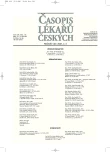Influence of Early Postnatal Nutrition in Preterm Infants on Their Anthropometric and Hormonal Characteristics at the Age of 10 Years
Vliv časné postnatální výživy u předčasně narozených dětí na jejich antropometrické a hormonální charakteristiky ve věku 10 let
Východisko.
Ochranný vliv kojení na rozvoj obezity byl jasně prokázán. Četné studie spojují vyšší příjem proteinů v postnatálním období s časnějším nástupem „adiposity rebound“ a vyšším body mass indexem v pozdějším věku.
Metody a výsledky.
Longitudinální studie se zúčastnilo 28 dívek narozených ve 34. týdnu těhotenství (porodní hmotnost: 2,2±0,3 kg, délka: 45,2±2,5 cm, body mass index (BMI): 11,0±1,5 kg/m²). Podle významně odlišného příjmu bílkovin v prvním měsíci po narození byly dívky rozděleny do dvou skupin (příjem bílkovin dívky kojené: 113,5±18,7 g/měsíc vs. příjem bílkovin dívky s náhradní mléčnou výživou: 174,0±14,3 g/měsíc; p<0,0001). Skupiny se nelišily v tělesné délce, hmotnosti a BMI při narození. U desetiletých dívek byly stanoveny antropometrické a hormonální charakteristiky, složení těla, příjem energie a makronutrientů a BMI jejich rodičů. Byl sledován vztah mezi časnou postnatální výživou a antropometrickými a hormonálními parametry v deseti letech. Při vyšetření v deseti letech nebyly kromě hladiny IGF-1 mezi skupinami zjištěny žádné rozdíly v antropometrických a hormonálních parametrech. Hladina IGF-1 v deseti letech byla signifikantně vyšší u skupiny s vyšším příjmem bílkovin po narození. Příjem bílkovin po narození nekoreloval s množstvím tukové tkáně a leptinu desetiletých dívek. Prokázali jsme však signifikantní pozitivní korelace mezi příjmem bílkovin po narození a IGF-1, BMI a tělesnými obvody v deseti letech. Postnatální příjem tuků koreloval s IGF-1, tělesnými obvody a navíc také se sagitálním rozměrem a hladinou leptinu v deseti letech.
Závěry.
Časná postnatální výživa by mohla ovlivňovat hladinu IGF-1 v pozdějším věku a ovlivňovat tak tělesný rozvoj. Faktorová analýza ukázala IGF-1 jako pojítko mezi postnatálním příjmem energie a makronutrientů, antropometrických parametrů a hladiny leptinu v deseti letech.
Klíčová slova:
postnatální příjem bílkovin, antropometrické parametry, tuková tkáň, leptin, IGF-1, předčasně narozené děti.
Authors:
H. Zamrazilová; V. Hainer; M. Černá 1; M. Kunešová; R. Braunerová; J. Štěpán 2; J. Nedvídková; M. Hill; J. Pařízková
Authors‘ workplace:
Endokrinologický ústav, Praha
; Ústav pro péči o matku a dítě, Praha
1; III. interní klinika 1. LF UK a VFN, Praha
2
Published in:
Čas. Lék. čes. 2007; 146: 278-283
Category:
Original Article
Overview
Backround.
A protective effect of breast feeding on the development of obesity has been clearly demonstrated. Several studies associated higher protein intake in postnatal period with the earlier “adiposity rebound” and the higher BMI in later life.
Methods and Results. Twenty eight girls born at 34th week of pregnancy (weight:
2.22±0.31 kg, length: 45.2±2.5 cm, BMI: 11.0±1.5 kg/m²), were subdivided in two groups differing in protein intake during the first postnatal month due to either breast feeding or formula feeding (113.5±18.7 g/month vs. 174.00±14.3 g/month; p<0.0001). Groups did not differ in average body weight, height and BMI at birth. Anthropometric and hormonal characteristics, body composition, energy and macronutrient intakes were determined at the age of 10 years in girls together with parental BMI. Association between the early postnatal nutrition and anthropometric and hormonal indexes at 10 years was evaluated. No significant differences between the groups in anthropometric and hormonal characteristics were found at 10 years except for IGF-1 which was significantly higher in the group with increased postnatal protein intake. Protein intake during the first postnatal month was not related to fat mass and leptin levels at 10 years. Protein intake during the first postnatal month significantly correlated with IGF-1 level, BMI and body circumferences at 10 years. Postnatal fat intake correlates with body circumferences and IGF-1 and also with sagital diameter and leptin at 10 years.
Conclusions.
Early postnatal nutrition could encode IGF-1 in later life and this way may be involved in body size programming. Factor analysis revealed IGF-1 as a link between the postnatal energy and macronutrient intake and anthropometric indices and leptin at the age of 10 years.
Key words:
postnatal protein intake, anthropometric indices, fat mass, leptin, IGF-1, preterm infants.
Labels
Addictology Allergology and clinical immunology Angiology Audiology Clinical biochemistry Dermatology & STDs Paediatric gastroenterology Paediatric surgery Paediatric cardiology Paediatric neurology Paediatric ENT Paediatric psychiatry Paediatric rheumatology Diabetology Pharmacy Vascular surgery Pain management Dental HygienistArticle was published in
Journal of Czech Physicians

- Metamizole vs. Tramadol in Postoperative Analgesia
- Metamizole at a Glance and in Practice – Effective Non-Opioid Analgesic for All Ages
- Advances in the Treatment of Myasthenia Gravis on the Horizon
- Metamizole in perioperative treatment in children under 14 years – results of a questionnaire survey from practice
- Possibilities of Using Metamizole in the Treatment of Acute Primary Headaches
Most read in this issue
- Neurosteroids and Their Function
- Relationships Between the „Eating Inventory“ Factors, Socioeconomic Status, Anthropometric Body Adiposity Indexes and Health Risks in Czech Population
- Obesity Based on Mutation of Genes Involved in Energy Balance
- Growth Hormone Treatment in the Institute of Endocrinology
